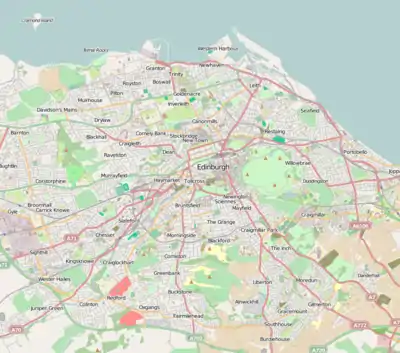Lady Stair's House
Lady Stair's House is a building, completed in 1892, which stands in Lady Stair's Close in Lawnmarket, Edinburgh, Scotland. The structure is a Category A listed building, having received its designation in 1970.[1] Today it is home to the Writers' Museum.
| Lady Stair's House | |
|---|---|
 The building in 2012 | |
| Location | Lady Stair's Close, Lawnmarket, Edinburgh |
| Coordinates | 55.949653°N 3.193686°W |
| Built | 1892 |
| Architect | Stewart Henbest Capper |
Listed Building – Category A | |
| Official name | Lawnmarket, Lady Stair's Close, Lady Stair's House |
| Designated | 14 December 1970 |
| Reference no. | LB29231 |
 Shown in Edinburgh | |
The current building is a faux-medieval work by Stewart Henbest Capper dating from 1892.[2] It was presented by the Earl of Roseberry (who probably commissioned the work) to the city for use as a museum in 1907. Only then did it acquire the name of "Lady Stair's House".[3] It incorporates replicas of various carved stones probably from the earlier building. The house it replaced was demolished in 1890.
Lady Stair's House (3 Lady Stair's Close, 477 Lawnmarket) is located within Lady Stair's Close, just off the Lawnmarket. The original house was built in 1622 for Sir William Gray of Pittendrum. The lintel over the entrance is dated 1622 and carries the initials WG and GS, for William Gray and Geida (or Egidia) Smith, his wife (sister of Provost John Smith of Grothill), and the inscription "FEARE THE LORD AND DEPART FROM EVILL". Their son was the Scots Worthy Andrew Gray whose books became well-known despite dying at an early age. The building was initially known as Lady Gray's House and the close known as Lady Gray's Close because Sir William Grey's wife, Lady Grey, continued to live in the house after his death in 1648.[4][5]
The tenement is now named after the Gray's granddaughter: the society beauty Lady Stair, Elizabeth, Dowager Countess of Stair (née Elizabeth Dundas), the widow of John Dalrymple, 1st Earl of Stair. She purchased the building in 1719.[6]
In 1825, Lady Stair's House was bought by John Russel, a brushmaker whose family lived in the house until 1895.[5]
In the 1890s, the original building was inherited by Archibald Primrose, 5th Earl of Rosebery. He was prompted to do so by the town planner Patrick Geddes, who had been campaigning for a renewal programme in Edinburgh's Old Town, largely demolished by the City Improvement Schemes of the 19th century.[5] The rebuilding of 1892 included nothing of the original building other than unseen basement areas. In 1907, the Earl gave the house to the royal burgh of Edinburgh, for use as a municipal museum.[7]
Lady Stair's House is designated a Category A listed building by Historic Environment Scotland.[1]
References
- Historic Environment Scotland. "Lawnmarket, Lady Stair's Close, Lady Stair's House (Category A Listed Building) (LB29231)". Retrieved 25 March 2019.
- Dictionary of Scottish Architects: S H Capper
- Edinburgh and District: Ward Lock Travel Guide 1930
- The Closes and Wynds of Edinburgh: The Old Edinburgh Club
- Wall Text, Lady Stair's House, Writer's Museum, Edinburgh
- "ROYAL-MILE.COM ROYAL MILE CLOSES: LOCHEND AND LADY STAIR'S CLOSE". www.royal-mile.com. Retrieved 25 August 2020.
- "Site Record for Edinburgh, Lawnmarket, Lady Stair's Close, Lady Stair's House NT27SE 64". Canmore. Edinburgh: Royal Commission on the Ancient and Historical Monuments of Scotland. Retrieved 29 September 2012.